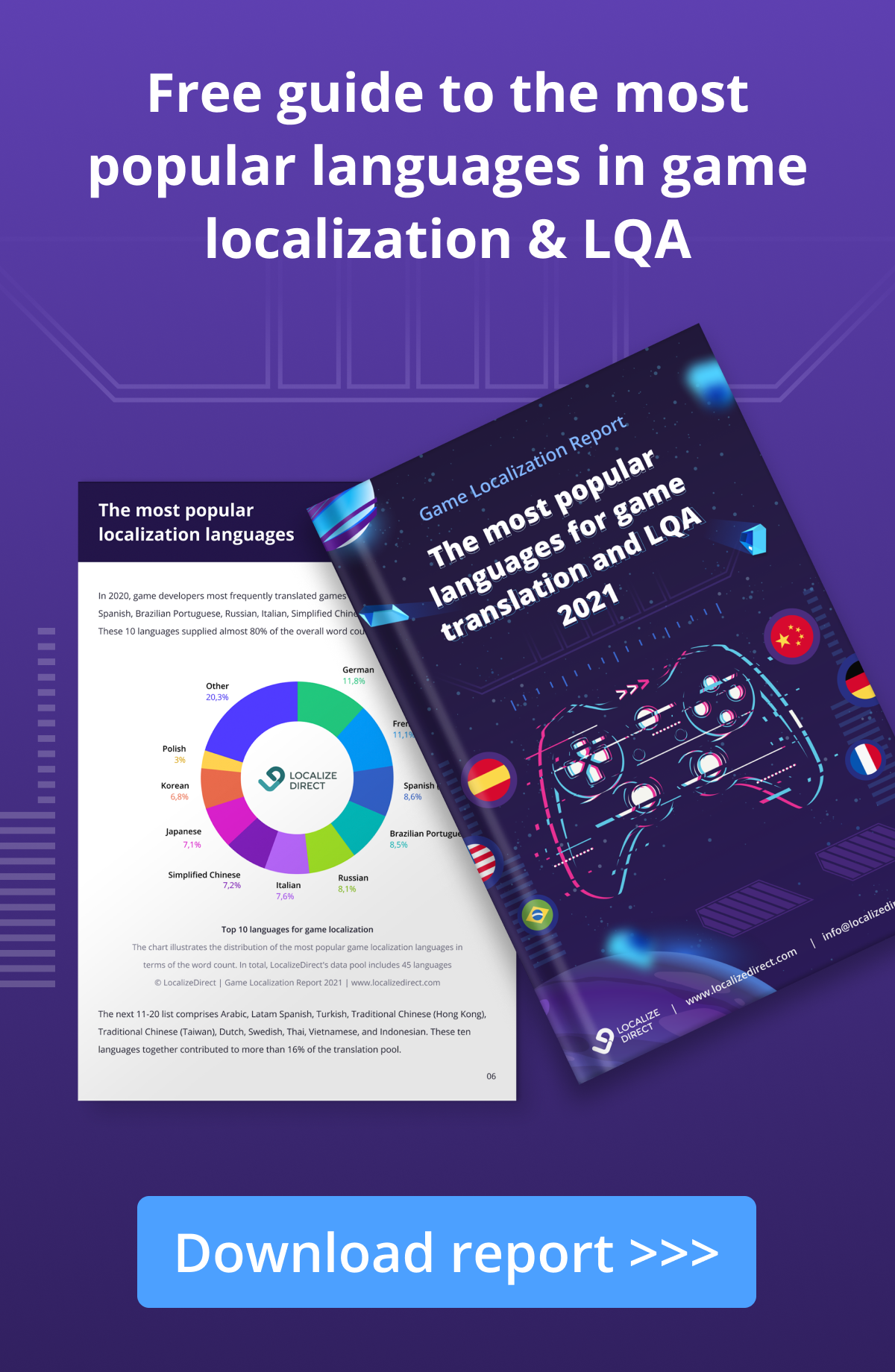Game localization in 2022: a summer snapshot

This blog isn’t going to tell you about the top 10 trends in gaming localization in 2022, because you’ve probably been reading those lists all year. Instead, we’re going to give you a snapshot of some of the things that have caught our attention in recent months and are shaping our thinking for the rest of the year and beyond. We’re sure you have your own ideas, and we’d like to hear them. Both the gaming industry and the localization industry thrive on interaction, so let’s interact. Why not join us for a joint-webinar? In the meantime, we hope you like the blog.
DETAIL, DETAIL, DETAIL
Game developers create a detailed world for gamers to inhabit, and a global community of almost 3 billion gamers have high expectations of gaming localization.
When you meet those expectations, they’ll be your biggest cheerleaders. When you let them down, they’ll share their displeasure. As we enter the second half of 2022, this is a good time to ask what gamers might be looking for.
At the beginning of this decade, relatively little attention was being paid to the inclusiveness of gaming language. True leaders don’t just listen to changing moods. They act on them. Kudos to our friends at Electronic Arts (EA), who set up a task force with the goal of taking a major step forward in inclusivity. Today, EA can point to inclusive language guides in 30 languages which share a continuous positive message. Gamers are smart. They’re receptive to positive social changes, and thanks to forward-thinking industry leaders they can now immerse themselves in language that reflects such changes.
In 2022, more than ever before, gamers expect an immersive experience. This may take the form of next-level virtual worlds in the growing Metaverse, or it may mean something as simple and essential as a good choice of voice artist from language to language. The dangers and rewards of Horizon Forbidden West became a global obsession this year. Sony pre-sold 20 million copies of the game, and its official launch in February dominated social media. Fans know Ashly Burch as the game’s lead English language voice actor. Her performance as Aloy has brought her fame and praise, and the wider success of the franchise depended heavily on localization that delivered similarly strong casting choices in other languages. As well as selling strongly in English-speaking markets, Forbidden West was a hit in Germany, selling over 200,000 copies in its launch month. Almost 50,000 copies of the PlayStation 4 version were sold in Japan in the first week of release, with sales for the PlayStation 5 version not far behind. Gaming localization has to mean delivering an immersive, multi-sensory experience that paints a picture the world wants to see and tells a story it wants to hear. Sony got it right with Forbidden West, and duly reaped the rewards.
Another major 2022 success story was delivered by Bandai Namco. Directed by Hidetaka Miyazaki and with design input from George R.R. Martin, hopes for Elden Ring were high. In the six months since the game’s release, those hopes have been fulfilled. Over 12 million copies were sold in less than a month, and leading industry analyst Mat Piscatella has confidently predicted that Elden Ring will be the number one premium game in the US in 2022.
And what’s the secret of this success? Gamers debate passionately about the fine details of language and tone, and rightly so. For the time that they inhabit this world, it belongs to them and they are entitled to speak up about anything that detracts from the user experience. Bandai Namco and Hidetaka Miyazaki’s previous work on the Souls series showed gaming localization at its best, with English language versions of the games including terms and phrases that the translators created themselves, with Miyazaki’s guidance. Some of these translated phrases were so insightful that they were incorporated into the original Japanese versions.
Like the gamers they serve, gaming localization professionals deserve a fully-formed environment to work in. Elden Ring takes place in the realm of the Lands Between. Players must travel across the realm, seeking scattered parts of the precious ring to make it complete. While this has obvious appeal for gamers, a similar real-life quest might be frustrating for gaming localization specialists. Searching the world for scattered translation assets is more of a chore than an adventure, and we see greater value in centralizing those assets for multiple stakeholders on a user-friendly platform, and having an easily accessible translation memory in place from the beginning of a project.
THE SOCIAL NETWORK
Facebook - or rather Meta - can teach us many things about the value of online networking, but it doesn’t have a monopoly. Gamers are part of a vibrant global social network. The cliché of the solitary gamer isolating themselves from others has always been misleading. Surveys consistently reveal that at least a quarter of all gamers play as a way of socializing with friends. Online multiplayer games often go hand-in-hand with subscription services that deliver news updates, discounts or free games. It’s notable that the only element of the US gaming market that’s forecast to expand year-on-year in 2022 is subscriptions. These services can only succeed when communication is crystal clear. Would you pay good money to subscribe to a service that left you guessing what you were paying for? Engaging, nuanced content localization is the key to keeping subscribers happy.
Gamers who are active on social media will tell the world precisely what they think of a new release, and strong opinions tend to find an audience. These people can be your champions. The increasing popularity of TikTok has seen a surge in short, snappy brand advocacy videos in 2022. When you take the time to localize your message, your users will take the time to publicly applaud you for it.
If the cliché of the solitary gamer is a fiction, then so is the cliché that gamers all fit neatly into one age bracket. A notable rise in older gamers in the 2020s isn’t just a response to various lockdowns. Game-playing has always been family-friendly. A few decades ago we might have seen three generations of the same family sitting around a table at Christmas playing Monopoly. That still happens, of course, but Christmas 2022 will also offer many examples of older generations using video gaming as a way of connecting with their children and grandchildren. We’ve often heard media executives speak of TV shows that crossed demographic divides; comedies that made the whole family laugh, game shows that made parents and children gather around the TV and pool their knowledge. In 2022, gaming is taking the place of television in that space.

So how can you connect with these users? How can you optimize your message for each member of this sprawling social network?
You can start with a platform that enables multiple project stakeholders to make multiple updates for multiple audiences. In other words, a gaming localization solution that’s as collaborative as gaming itself.
FASTER, HIGHER, STRONGER - TOGETHER
In recent years the possibility of gaming becoming part of the Olympics has been widely discussed. The Olympic motto was rewritten in 2020 to reflect the importance of inclusion. “Faster, Higher, Stronger - Together” is the call to action for the 2020s, and gaming unites players of all generations and backgrounds in friendship. This August, the Commonwealth Games gave us a glimpse of how gaming might take its place on the Olympic schedule. This event welcomed women and men from 56 countries with a total population of 2.5 billion.
On August 6th and 7th, 100 players representing 20 different Commonwealth nations fought for medals in three different video games: Rocket League, Dota2 and eFootball. The trial was a success, and the President of the Commonwealth Games Federation, Dame Louise Martin, happily told the world’s media that she believed gaming would be a regular fixture in the event.
What could this mean to Commonwealth competitors from South Africa, with its eleven official languages? Or to speakers of the 525 native languages of Nigeria? Or to gamers from India, a country in which over 19,500 languages and dialects are spoken? And what could it mean to the billions more who may find their countries challenging for gaming medals in the Los Angeles Olympics in 2028?
It will mean that for them to be competing on a level playing field, and getting the satisfaction and enjoyment they deserve from the activities they love, gaming content will need to be localized to the highest possible standard. And it will mean that the Olympic motto of “Faster, Higher, Stronger - Together” will need to be a mantra for game localization professionals, every bit as much as it is for elite athletes.
THE RULES MAY CHANGE, BUT THE GAME REMAINS THE SAME
And the name of the game is find your audience.
The purpose of gaming localization is to make the player feel as if the game was designed specifically for them. You know how to do this and we know how to help you.
- Localize idioms to reflect each target culture
- Edit user interfaces and game menus with diligence and skill
- Tailor soundtracks and other audio features for regional appeal
- Pay close attention to each market’s historical and cultural references
- Deliver subtitling and voice-overs that truly speak to the gamer
Each member of your target audience is an individual. Picture yourself cooking a souffle for a special dinner guest. Whether it rises or falls is entirely up to you.
Give each person what they want. Reach out to them, and they’ll hold out a hand in return. It will be a hand of friendship, and, let’s be honest, it will be holding a credit card. Serious gamers spend serious money. Claim your share with smart localization and smart localization tools, starting right now.
